The challenge to convert more leads without resorting to the usual, tired-and-traditional, in-your-face sales tactics (and how to get it done) is our topic in today’s blog post.
Sales-y. It’s a word that strikes fear into the heart of every true marketer.
To be called “sales-y” is to be accused of (pretty much) everything good marketing isn’t — icky, manipulative, inauthentic, and generally just not cool.
Nobody wants to create messaging or content that comes across as sales-y because it feels… well, slimy.
You might even say that if you’re resorting to being “sales-y,” you haven’t done a good enough job of creating demand. Instead, you’re forcing demand.
You’re reaching out to someone who doesn’t want to hear from you, doesn’t want to buy what you’re selling, and doesn’t want to give you their email address or even their name.
In short, you’re pitching and selling to someone who doesn’t care.
(Which is a pretty crappy sales experience for everyone involved.)
These days, to convert more leads into customers, you need to learn to sell without selling. Specifically, you must take your prospects through the awareness, interest, and desire stages without resorting to cheap tactics.
A lot of people have the misconception that demand generation and lead generation are somehow the same thing.
Read more about the difference between the two concepts here in our related piece, “Demand Generation vs. Lead Generation: What’s the Difference?”
Demand Generation Is Key To Converting More Leads
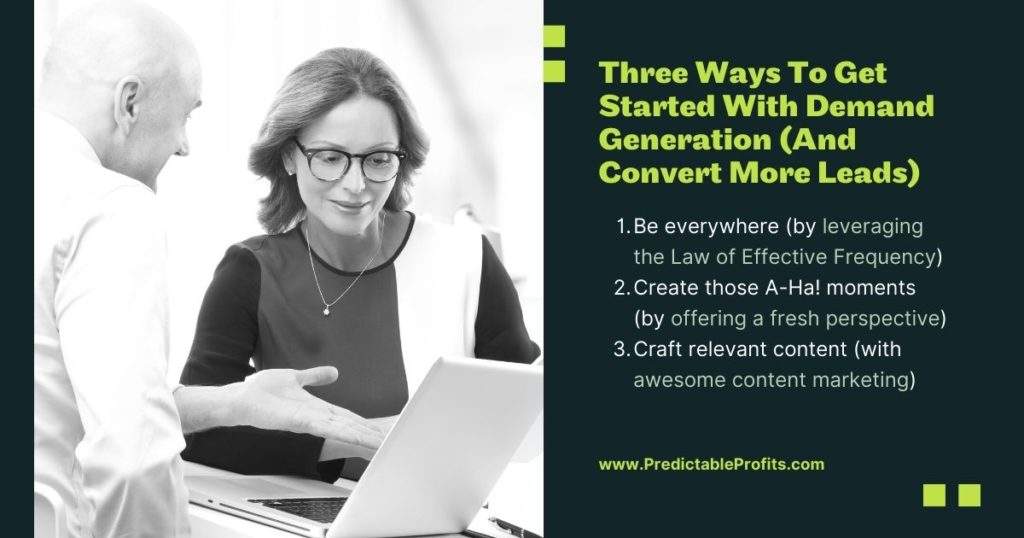
What exactly does demand generation have to do with your sales efforts?
Demand generation is more than just building awareness and drumming up interest in your brand and what you have to offer. It’s also about filling your pipeline with a steady flow of leads that will ultimately translate into sales opportunities for your sales team.
Check out our notes from one of our Live Sessions, “Demand Generation: How to Fill Your Sales Pipeline.” You can also listen to the Beyond 7 Figures podcast episode with Zach Burkes.
You could even say that demand generation is becoming a fundamental part of business strategy, and a sales funnel is no longer complete without it.
We talk a lot about the importance of demand generation here at Predictable Profits. And for our discussion, you create demand by:
Being Everywhere
By being everywhere, you’re leveraging the Law of Effective Frequency; your product or service is always top-of-mind with your prospects.
We have found that the best way to do this is to use a combination of content on various digital and offline marketing channels.
Being active on social media will undoubtedly be part of your strategy, but don’t forget your retargeting efforts, video, podcasts, events, and even mobile chat apps, if you have them.
Creating Those “A-Ha!” Moments
We’re talking about those moments of clarity that get your prospects to sit back and say: “Wow! This changes everything!”
They need to understand why your offer differs from anything they’ve done or tried in the past.
You’re not selling a product or service; you’re selling an idea. There’s a massive difference between the two.
Crafting Relevant Content
Content creation has always been an important part of marketing, but it is now becoming increasingly essential to business success.
In the past, businesses could rely on traditional marketing techniques to generate leads and drive sales. However, the digital age has changed all that.
Today, customers are bombarded with marketing messages from all sides, and they have become much more savvy about tuning out advertising that is not relevant to them.
As a result, businesses must now work harder to capture attention and create demand for their products or services.
Content creation is one of the most effective ways to do this
By creating helpful, informative, and engaging content, businesses can establish themselves as thought leaders in their industry and build trust with potential customers.
The Importance of Nurturing Your Leads (Toward Conversion)

With demand generation in mind, you can convert your prospects and leads into paying customers without high-pressure sales tactics.
Partly, this involves creating connections that position you as helpful and trustworthy. You must also bring something new to the conversation that goes beyond solving your customers’ problems.
Remember: our goal is to create those “A-ha!” moments.
You want to keep your prospect interested and intrigued with your message. But more than that, you want to inspire change. You need to bring a fresh perspective.
One of our favorite stats here at Predictable Profits comes from the legendary Chet Holmes, author of the NYT best-selling book, “The Ultimate Sales Machine.”
If you think about your prospects and your sales efforts, Chet Holmes says that:
- 3% are interested in buying right now,
- 7% are open to buying from you,
- 30% are not even thinking about you, your products, or your services,
- 30% don’t think they’re interested,
- and 30% are definitely not interested at all.
This means if you were to launch a marketing campaign right now, you could expect about 10% of your target audience to be interested in what you have to offer– 3% could buy right away, and another 7% a bit later on.
Forget about the 30% not interested in you at all. What about the other 60% of your leads? This is where your nurturing efforts come in– creating relevant, educational, helpful content while staying top-of-mind and somehow establishing your expertise and authority.
You can start by nurturing that relationship.
You do that by providing real value and education that highlights how your prospects’ lives or their businesses can be better with your product or service so that eventually, they decide they want to do business with you too.
To Convert More Leads, Start Building That Relationship (Here's How)
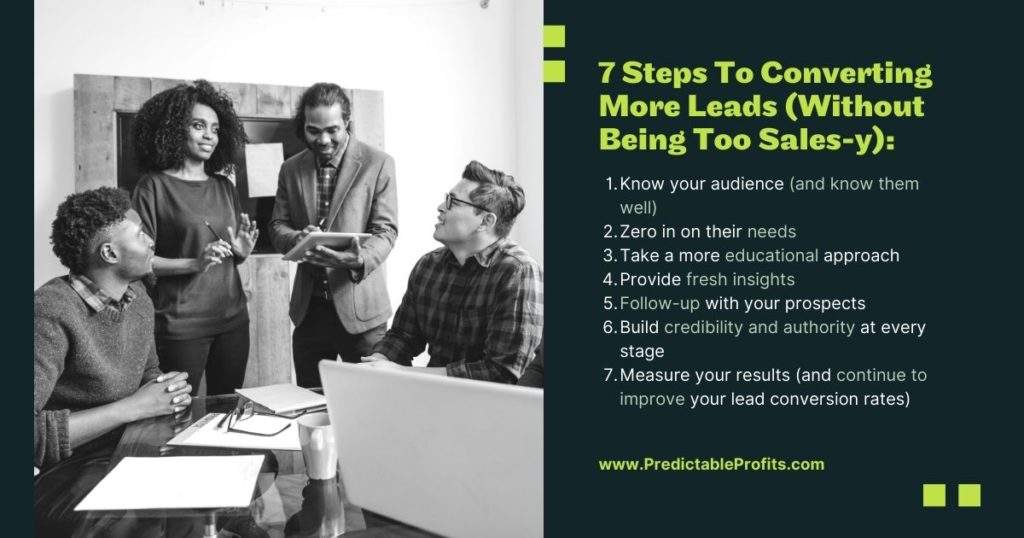
Building relationships is key to any successful (and sustainable) sales effort. You must nurture those relationships and stay top-of-mind so that when they’re ready to buy, they think of you first.
Studies have consistently shown that consumers today buy on their own time– not ours. People loop through twin modes of exploration and evaluation, repeating the cycle as often as they need to make a purchase decision.
It might sound complex, but for consumers, it just feels like everyday shopping– that’s just the way it is. Again, rather than forcing the sale, you can nudge them gently ahead by providing them with the information and reassurance they need to make a decision.
1. Know your audience (and know them well)
The key to a successful conversion is understanding your audience. Beyond knowing who they are and what they want, you want to understand what motivates them and details such as items they value or where they spend their time online.
This is where establishing rapport comes in.
Building rapport is essential to converting potential customers without selling them your products or services.
This means getting to know them as a person rather than treating them as just another sale. What are their interests? How can you connect on a personal level?
When you build rapport, conversions follow.
Knowing your audience allows you to tailor your experiences, making a conversion to a sale easier. The more accessible you make yourself to your audience, the more likely they will follow through.
2. Zero in on their needs
When you know your audience’s needs, you can provide solutions to their pains.
Here at Predictable Profits, we talk about bridging the gap between where your customers are right now and where they want to be. The information we provide helps fill that gap in order to make a buying decision.
This can be done by asking questions and listening to answers. Once you know their needs, you can find the right solution, help solve their problems or provide new insight into their situation.
Take note: We are now dealing with more discerning buyers who have looked at 27 different sources of information before making a buying decision.
So rather than forcing the sale, think about supporting the buying process instead. Take time to find the solution that fits them perfectly. And then present it in a way that makes the most sense for their situation.
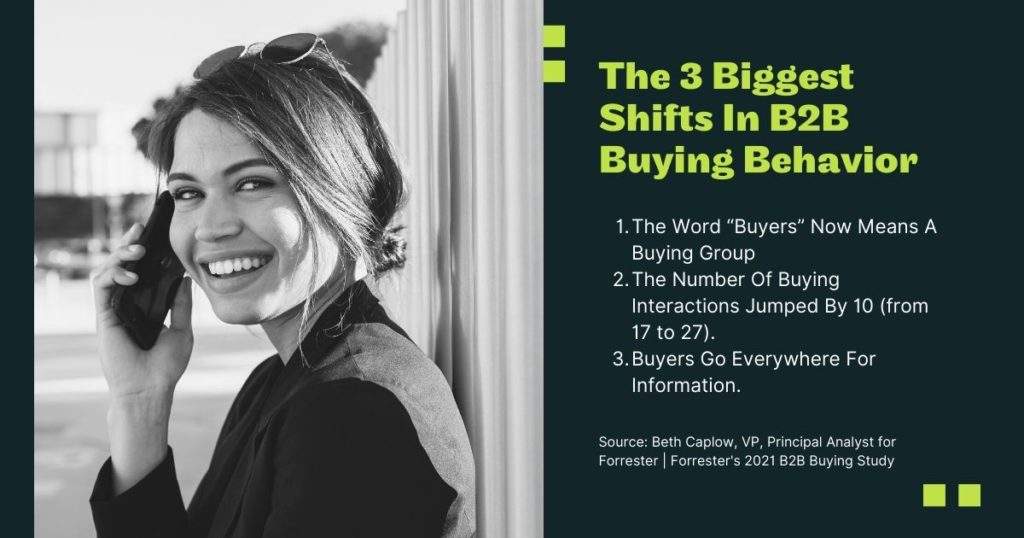
3. Take a more educational approach
We live in a time when buyers have become researchers. More than ever, you should take a more educational approach instead of selling traditionally.
According to a Forrester study. the average buyer looked at 17 different sources of information before making a buying decision in 2019. Just two years later (in 2021), that number went up to 27 different sources of information.
With so much information so easily accessible, buyers are already finding answers online and answering their own questions through research.
This is where creating and offering valuable resources becomes helpful. These can be everything from eBooks and cheat sheets to templates and online tools.
Taking an educational approach is all about providing real value. If you offer something people need or find helpful, they’re more likely to engage with you.
You want to show potential customers that you’re not just out to make a quick buck but also interested in helping them solve problems.
Whether entering their contact details, booking an appointment, or requesting more information, providing education makes it easier to nudge your prospects down your pipeline.
Not sure what sort of topics to cover? Ask your salespeople. They know precisely what kind of questions your customers commonly bring up. Or what specific concerns or pain points they might have.
Other quick wins to cover:
- How do you compare against your competitors?
- What pricing tiers do you have available?
- The process of signing up for your services or purchasing your products
- What sort of guarantees do you have?
- What are the common problems addressed by using your products and services?
- How are you doing in terms of client testimonials and reviews?
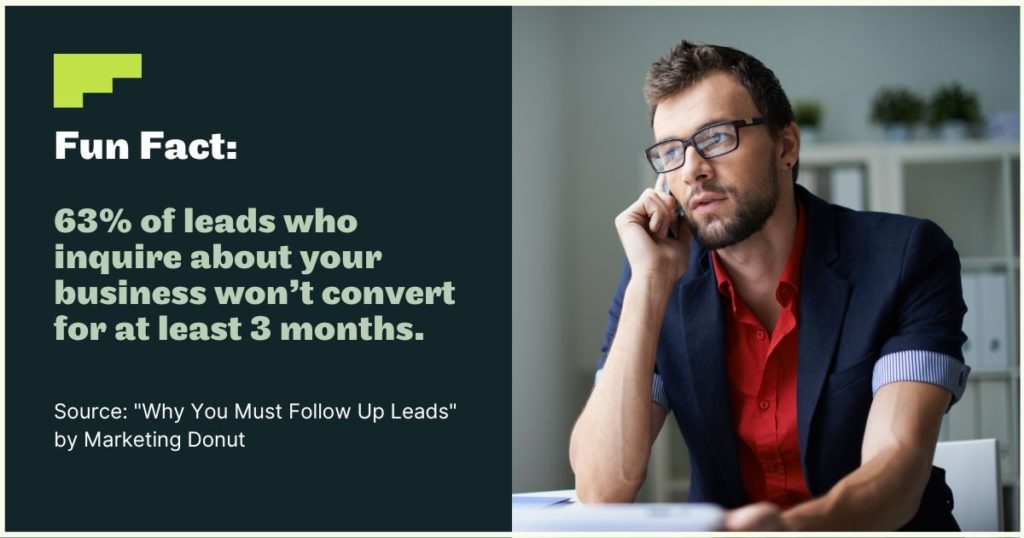
4. Provide fresh insights
The first three items we discussed — knowing your customer, focusing on their needs, and adopting a more educational approach — can be taken further by providing fresh insights.
According to a RAIN Group study, top-performing sales pros tend to consistently educate buyers with new ideas and perspectives, bringing tremendous value to the table this way.
In other words, the top sales performers drive demand. They create their own opportunities and become essential to the buyer.
Bringing something new to the table is a skill that all sales professionals should nurture. Fresh perspectives trigger those “A-Ha!” moments with your customers.
By showing you have a unique and deeper understanding of your industry, people are more likely to take note of what you say.
5. Follow-up with your prospects
As we always say around here at Predictable Profits, “the money is in the follow-up.”
Fun fact: 63% of leads who inquire about your business won’t convert for at least three months.
By doing a systematic follow-up, you keep your company’s name in front of prospects and build relationships that can eventually lead to sales.
Yes, you should employ marketing automation tools to aid in follow-up (and retargeting campaigns). But you can also expand your follow-up game by engaging with your prospects and leads on social media, for example.
The point is to stay top-of-mind and show you’re always available for them. Staying active on social media and responding promptly to prospects’ questions or concerns can greatly contribute to your follow-up efforts.
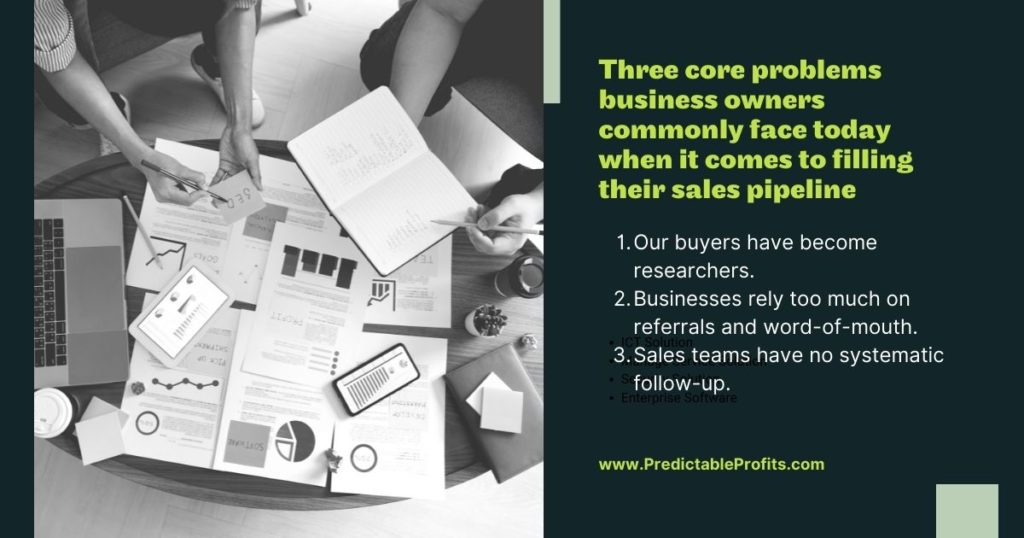
6. Build credibility and authority at every stage
Again, today’s buyers today have become researchers. They’re more discerning and deliberate when making decisions.
Specifically, buyers consider two brand factors before becoming customers: credibility and authority.
When we discuss credibility, we’re talking about proof– social proof in the form of testimonials, reviews, or recommendations from others. These can be very persuasive in influencing purchasing decisions.
Buyers constantly look for proof that happy customers purchased what’s being offered. Demos, trials, and case studies are also great ways of establishing proof.
You should also have that element of authority. You can continue to build authority through media or press coverage, getting featured in podcasts or YouTube channels, being active in organizations and events within your space, and so on.
7. Measure your results (and continue to improve your lead conversion rates)
If you’re not measuring your lead conversion rates, you’re missing out on valuable data that can improve your marketing and sales efforts.
By understanding what’s working (and what isn’t), you can adjust your strategy to make the most of your time and resources.
Optimizing your conversion rates, after all, means more conversions (without selling)!
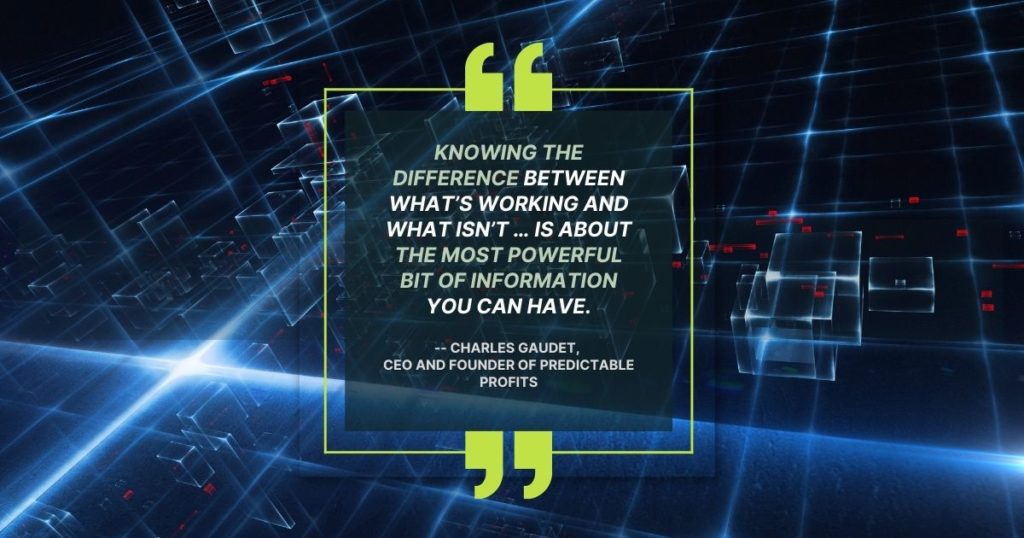
A Final Word on Converting More Leads Into Customers (Without Being Too Sales-y)
Nobody wants a pushy salesperson. Or someone you know is just looking for the perfect moment to break into a sales pitch.
This blog post shows you that you can convert leads and close deals without relying on traditional, in-your-face methods.
By focusing on creating strong relationships, providing valuable content and sharing new insights that help solve problems, prospects are more likely to do business with you — and perhaps even keep coming back.
If you’d like to take your sales team to that next level, get in touch with us here at Predictable Profits and ask about our signature Sales Training Program.
Our proven marketing methodology helps you achieve predictable results and establish a competitive edge through innovative ideas and concepts guaranteed to eliminate inefficiencies and improve productivity and performance while increasing your sales volume throughout the year.
Start with a free strategy session with the Predictable Profits team today.
Be part of our ever-growing community of seven- and eight-figure business owners:
- Check us out on the Predictable Profits YouTube channel.
- Connect with us on Linkedin.
- Join other entrepreneurs (like yourself) on our Facebook page.
- And if you haven’t already, sign up for our daily business coaching video series (by entering your email address below).
